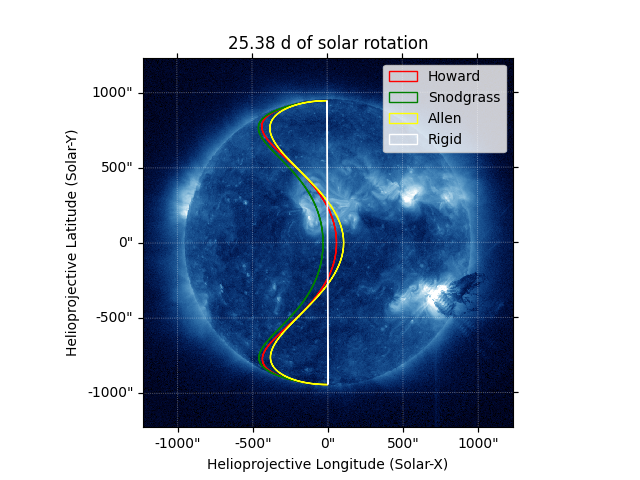Note
Go to the end to download the full example code
Comparing differential-rotation models#
How to compare differential-rotation models.
The example uses the RotatedSunFrame coordinate
metaframe in sunpy.coordinates to apply differential rotation to a coordinate.
See Differential rotation using coordinate frames for more details on using
RotatedSunFrame.
import matplotlib.pyplot as plt
import astropy.units as u
from astropy.coordinates import SkyCoord
import sunpy.map
from sunpy.coordinates import HeliographicStonyhurst, RotatedSunFrame
from sunpy.data.sample import AIA_335_IMAGE
from sunpy.sun.constants import sidereal_rotation_rate
First, we use an AIA observation primarily as a pretty background. We also define the meridian using a two-element coordinate array of the south pole and the north pole at zero longitude.
aiamap = sunpy.map.Map(AIA_335_IMAGE)
meridian = SkyCoord(0*u.deg, [-90, 90]*u.deg, frame=HeliographicStonyhurst,
obstime=aiamap.date)
Next, we calculate the sidereal rotation period of the Sun. This is the time for a full rotation relative to an inertial reference frame (e.g., distant stars), as opposed to the synodic period, which is the apparent rotation period as seen from an Earth-based observer. Since the Earth orbits the Sun in the same direction as the Sun rotates, the Sun appears to rotate slower for an Earth-based observer.
sidereal_period = 360*u.deg / sidereal_rotation_rate
print(sidereal_period)
25.379994924001014 d
We use RotatedSunFrame to rotate the
meridian by one sidereal period using each of the available
differential-rotation models. See
diff_rot() for details on each
model.
rotated_meridian = {}
for model in ['howard', 'snodgrass', 'allen', 'rigid']:
rotated_meridian[model] = SkyCoord(RotatedSunFrame(base=meridian,
duration=sidereal_period,
rotation_model=model))
Finally, we plot the differentially rotated meridians over the map, using
draw_quadrangle() to conveniently draw a line
of constant longitude in the original frame between two endpoints. (One
could instead use astropy.visualization.wcsaxes.WCSAxes.plot_coord(),
but then meridian would need to consist of a sequence of many points
spanning all latitudes between the two poles to render as desired.)
Note that the “rigid” model appears as the meridian again as expected for a
rotation of exactly one sidereal period.
fig = plt.figure()
ax = fig.add_subplot(projection=aiamap)
aiamap.plot(axes=ax, clip_interval=(0.5, 99.9)*u.percent)
colors = {
'howard': 'red',
'snodgrass': 'green',
'allen': 'yellow',
'rigid': 'white',
}
for model, coord in rotated_meridian.items():
aiamap.draw_quadrangle(coord, axes=ax, edgecolor=colors[model],
label=model.capitalize())
ax.legend()
ax.set_title(f'{sidereal_period:.2f} of solar rotation')
plt.show()

Total running time of the script: (0 minutes 1.046 seconds)